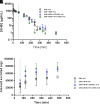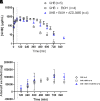γ-Hydroxybutyric Acid-Ethanol Drug-Drug Interaction: Reversal of Toxicity with Monocarboxylate Transporter 1 Inhibitors
- PMID: 33963018
- PMCID: PMC8456515
- DOI: 10.1124/jpet.121.000566
γ-Hydroxybutyric Acid-Ethanol Drug-Drug Interaction: Reversal of Toxicity with Monocarboxylate Transporter 1 Inhibitors
Abstract
The drug of abuse, γ-hydroxybutyric acid (GHB), is commonly co-ingested with ethanol, resulting in a high incidence of toxicity and death. Our laboratory has previously reported that GHB is a substrate for the monocarboxylate transporters (MCTs), necessary for its absorption, renal clearance, and tissue distribution, including across the blood-brain barrier. Our goal was to investigate the drug-drug interaction (DDI) between GHB and ethanol and to evaluate MCT1 inhibition as a strategy to reverse toxicity. The toxicokinetics of this DDI were investigated, including brain-to-plasma concentration ratios, in the presence and absence of ethanol. The toxicodynamic parameters examined were respiratory depression (breathing frequency, tidal volume) and sedation (time of return-of-righting reflex). Ethanol was administered (2 g/kg i.v.) 5 minutes before the intravenous or oral administration of GHB, and MCT1 inhibitors AZD-3965 and AR-C155858 (5 mg/kg i.v.) were administered 60 minutes after GHB administration. Ethanol administration did not alter the toxicokinetics or respiratory depression caused by GHB after intravenous or oral administration; however, it significantly increased the sedation effect, measured by return-to-righting time. AZD-3965 or AR-C155858 significantly decreased the effects of the co-administration of GHB and ethanol on respiratory depression and sedation of this DDI and decreased brain concentrations and the brain-to-plasma concentration ratio of GHB. The results indicate that ethanol co-administered with GHB increases toxicity and that MCT1 inhibition is effective in reversing toxicity by inhibiting GHB brain uptake when given after GHB-ethanol administration. SIGNIFICANCE STATEMENT: These studies investigated the enhanced toxicity observed clinically when γ-hydroxybutyric acid (GHB) is co-ingested with alcohol and evaluated strategies to reverse this toxicity. The effects of the novel monocarboxylate transporter 1 (MCT1) inhibitors AR-C155858 and AZD-3965 on this drug-drug interaction have not been studied before, and these preclinical studies indicate that MCT1 inhibitors can decrease brain concentrations of GHB by inhibiting brain uptake, even when administered at times after GHB-ethanol. AZD-3965 represents a potential treatment strategy for GHB-ethanol overdoses.
Copyright © 2021 by The American Society for Pharmacology and Experimental Therapeutics.
Figures








Similar articles
-
Treatment of γ-Hydroxybutyric Acid and γ-Butyrolactone Overdose with Two Potent Monocarboxylate Transporter 1 Inhibitors, AZD3965 and AR-C155858.J Pharmacol Exp Ther. 2019 Jul;370(1):84-91. doi: 10.1124/jpet.119.256503. Epub 2019 Apr 22. J Pharmacol Exp Ther. 2019. PMID: 31010842 Free PMC article.
-
A Novel Monocarboxylate Transporter Inhibitor as a Potential Treatment Strategy for γ-Hydroxybutyric Acid Overdose.Pharm Res. 2015 Jun;32(6):1894-906. doi: 10.1007/s11095-014-1583-0. Epub 2014 Dec 6. Pharm Res. 2015. PMID: 25480120 Free PMC article.
-
Drug-drug interaction between diclofenac and gamma-hydroxybutyric acid.Biopharm Drug Dispos. 2021 Sep;42(8):351-358. doi: 10.1002/bdd.2296. Epub 2021 Jul 8. Biopharm Drug Dispos. 2021. PMID: 34191301 Free PMC article.
-
Monocarboxylate transporter 1 and 4 inhibitors as potential therapeutics for treating solid tumours: A review with structure-activity relationship insights.Eur J Med Chem. 2020 Aug 1;199:112393. doi: 10.1016/j.ejmech.2020.112393. Epub 2020 May 1. Eur J Med Chem. 2020. PMID: 32388280 Review.
-
Overview of the proton-coupled MCT (SLC16A) family of transporters: characterization, function and role in the transport of the drug of abuse gamma-hydroxybutyric acid.AAPS J. 2008 Jun;10(2):311-21. doi: 10.1208/s12248-008-9035-6. Epub 2008 Jun 4. AAPS J. 2008. PMID: 18523892 Free PMC article. Review.
Cited by
-
Interaction between γ-Hydroxybutyric Acid and Ethanol: A Review from Toxicokinetic and Toxicodynamic Perspectives.Metabolites. 2023 Jan 25;13(2):180. doi: 10.3390/metabo13020180. Metabolites. 2023. PMID: 36837798 Free PMC article. Review.
-
Sex and Cross-Sex Testosterone Treatment Alters Gamma-Hydroxybutyrate Acid Toxicokinetics and Toxicodynamics in Rats.Pharmaceutics. 2024 Jan 21;16(1):143. doi: 10.3390/pharmaceutics16010143. Pharmaceutics. 2024. PMID: 38276513 Free PMC article.
References
-
- Cook CD, Biddlestone L, Coop A, Beardsley PM (2006) Effects of combining ethanol (EtOH) with gamma-hydroxybutyrate (GHB) on the discriminative stimulus, locomotor, and motor-impairing functions of GHB in mice. Psychopharmacology (Berl) 185:112–122. - PubMed
Publication types
MeSH terms
Substances
Grants and funding
LinkOut - more resources
Full Text Sources
Other Literature Sources
Research Materials

